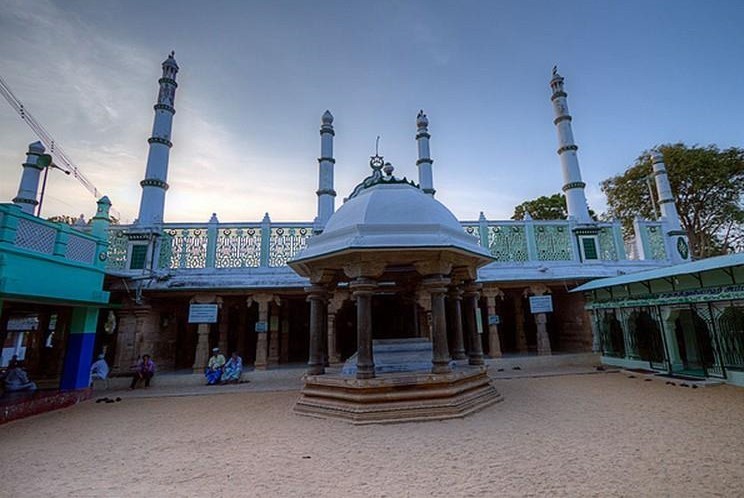South India, which is generally popular for its Hindu temples, has a hoary history of mosques, and this new series will bring forward these mosques. Series on south Indian mosques will highlight the oldest, most popular Muslim worshipping places in this part of the country.
Temple-Mosque stands Testimony of Time
Kilakarai (the shore down under) is a remote and small town in Ramanathapuram district and very close to the district headquarters of the same name. The place was famous as a flourishing sea port and a gateway to South India for Arab traders in search of the famed pearls of Madurai and corals of the Gulf Mannar. Even today, the descendants of the Yemeni traders live in Ramanathapuram district and do business between India and the island.

Kilakarai is surrounded by small islands and lovely little bays that could be a swimmers paradise. It was visited by the Arab traveler Ibn Batuta in 1368-69 CE who we it Lebbat Pattan (town of Muslims: Labbai means Tamil Muslim and pattan is a corruption of patnam or pattinam meaning town.) He noted that it is the place where most Arab settlers live and he was surprised to see them living as in Arab land.
Must Read: Islam and Sufism :Philosophy of Sufism
Temple-Mosque !
Kilakarai is more famous for islands and bays, but for the mosque which looked like a temple. Interestingly the place is inhabited by Tamil Arabs, who are living here since ages. Tamil Arabs, Temple-Mosque, a Sunni mosque, all these sound interesting, isn’t it? This is what makes this place a must watch pilgrimage.

Kilakarai has lots of Tamil Muslims, who form nearly 80% of the local population. Men are seen wearing white veshtis (dhoties), shirts and black topis (caps) and women in saris, with a white cloth thrown over their head. They were the Muslims of my youth, before the trademark black burkha made its appearance. The Muslims of Kilakarai look like Tamils and speak Tamil.
Read Also: Eight British Muslims Cycling their way to Haj
The Old Jumma Masjid (also called Meen Kada Palli) was constructed by Yemeni merchants and traders of the pre-Islamic period who had settled in the kingdom of the Pandyas of Madurai. The story goes that Badhan ibn Sasan, Persian Governor of Yemen during the reign of Khoshrau II, was ordered by his ruler to send men to Madina in 625 CE to bring the future Prophet Mohammed to Khosrau II.
Badhan sent two men for this task who demanded that Mohammed should come with them. Muhammad refused, and prophesied that Khoshrau II had been overthrown and murdered by his son Kavadh II. The two men returned to Badhan with this information.
When it proved to be true, Badhan converted to Islam and sent a message to Muhammad, informing him of his conversion, after which Mohammad allowed Badhan to continue ruling over Yemen. The two men, and Persians and Arabs living in Yemen and outside Yemen were ordered by Badhan to convert to Islam, which they did in 628. This included the Arab traders from Yemen who had settled in Kilakarai.

Chola mosques resemble Chola temples a small chamber replaces the garba griha, with a pillared mandapa and beautifully carved pillars in front. Only images of gods, people and animals are missing, for these are taboo in Islam.
In the 11th century, the mosque was rebuilt, and again in the 17th century by a workforce and materials provided by the erstwhile ruler of Ramnad and some by the Kilakarai merchants. However, the mosque still looks like a stone temple both outside and inside, without images carved on the pillars or walls.
The lone carving on the wall, like all mosques, identifies the direction of prayer, which is the only indication that it is a mosque.

This exquisite pallivasal resembles a Dravida-style temple. The beams are beautifully carved, while a bend in the wall indicates the direction of prayer.
This beautiful building is one of the best examples of Islamic Dravidian architecture of ancient India.
Read Also : Islam Tree: Detailed History of Islam
The oldest mosque in India
The Palaiya Jumma Masjid beats the Cheraman Jumma Masjid in Kodungallur, Thrissur district, Kerala, by one year and is considered the oldest mosque in India.
It was built in 628 CE, while the Kodungallur mosque was built in 629 CE by Malik lbn Dinar. Bazan Ibn Sasan, Tamim Ibn Zayd al Ansari, Ibn Batuta, Nagoor Abdul Kadir, Eravadi Ibrahim Sahib, the Sultan of Ottoman, Murad and other famous Islamic scholars have recorded their visits to the Kilakarai mosque. It is also the fourth oldest mosque in the world.
Vallal Seethakathi is buried at Kilakarai, in a modern colonial monument. He encouraged Umaru Pulavar, a Tamil Muslim, to write the Seerapuranam, a history of Nabi (Prophet) Mohammed, in 5,027 poems in three kaandams (parts). Beside the mosque, is the dargah of Sadakatullah Appa, a Muslim trader-benefactor.

Muslims from Kerala sing bhajans of sorts about Sadakatullah. With the growth of Madras and Tuticorin harbours and the cultured pearl industry, this little port ceased to be and returned to its pre-Arab slumber. The cultured pearl industry choked the once robust pearl trade or muthu salabam. The conch and coral industries declined too, as environmental concerns and excessive coral withdrawals restricted this activity. With the advent of surface transport, Kilakarai ceased to be a harbour and port.
But the temple-mosque of Kilakarai stands as a testimony of time and is still an attraction for many and a interesting pilgrimage for others.
@religionworldin
[video_ads]
[video_ads2]









